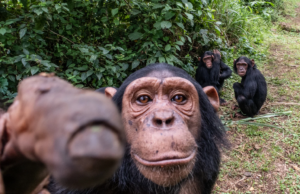New Web Tool Facilitates Joint Efforts to Protect Great Apes and Fight Climate Change

A web-based tool that superimposes maps of valuable underground carbon stocks with great ape distribution in Africa and Asia – thereby making the strongest possible argument for protecting both – was launched in April in Monrovia, Liberia, by the Great Apes Survival Partnership (GRASP) and the United Nations Collaborative Programme for Reducing Emissions from Deforestation and Forest Degradation (UN-REDD Programme).
The GRASP – REDD+ Mapping Project was introduced at the GRASP Regional Meeting – West Africa, which brought together partners from nine West African countries to discuss key conservation issues in the region.
The GRASP – REDD+ Mapping Project is designed to identify priority areas for implementing REDD projects when also considering co-benefits for the conservation of great apes. The maps are designed to help decision-makers, climate specialists and conservation organizations access data and link the carbon and great ape layers with other context data.
Achim Steiner, Executive Director of the U.N. Environment Programme (UNEP), said, “collaborative efforts are not only imperative to achieving the Sustainable Development Goals, but are at the very core of the Agenda 2030. I am therefore pleased that two global programmes that UNEP supports have joint forces to enhance two areas of vital concern, great ape conservation and forest protection.”
Harrison S. Karnwea, Managing Director of Liberia’s Forestry Development Authority (FDA) called the GRASP-REDD+ Mapping Project an importance resource.
“This will help us a great deal here in Liberia,” he said. “It will help us in determining which areas are important and should receive our highest priority. Conservation is a great resource, and applying it scientifically in this way is very innovative.”
GRASP and UN-REDD worked with the Max Planck Institute for Evolutionary Anthropology to develop the on-line tool, which can be accessed through the Ape Populations, Environments and Surveys (A.P.E.S.) database, a web-based decision support system http://primatdbext.eva.mpg.de/redd/.
“It is increasingly important that conservation efforts work closely together, particularly in areas of mutual concern,” said GRASP coordinator Doug Cress. “You cannot protect apes in Africa or Asia without also protecting the forests in which they live, and this project does an excellent job of emphasizing the overlap. GRASP and UN-REDD have a number of shared priorities, and we will further intensify our collaboration.”
The GRASP–REDD+ Mapping Project places special emphasis on potential corridor areas that could link fragmented and endangered great ape populations and have the potential for reforestation.
Carbon stocks perform essential ecological functions and supply clean water and air. The loss of these stocks through agricultural development, logging and fires can account for up to 20 per cent of global greenhouse gas emissions. In order to limit the impacts of climate change, it will be necessary to reduce emissions from the forest sector.
Source: GRASP – http://www.un-grasp.org/new-web-tool-facilitates-joint-efforts-to-protect-great-apes-and-fight-climate-change/

 Español
Español
 Português
Português








